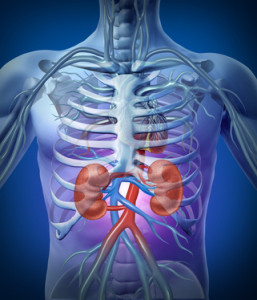 Solid tumors require the growth of new blood vessels (angiogenesis) for oxygen and nutrient supply. This concept is nowadays solidly accepted and has spurred substantial efforts to develop anticancer therapeutics that interfere with tumor angiogenesis. Most current therapies are designed to block the vascular endothelial growth factor (VEGF) signaling pathway.
Solid tumors require the growth of new blood vessels (angiogenesis) for oxygen and nutrient supply. This concept is nowadays solidly accepted and has spurred substantial efforts to develop anticancer therapeutics that interfere with tumor angiogenesis. Most current therapies are designed to block the vascular endothelial growth factor (VEGF) signaling pathway.
VEGF’s normal function is to initiate blood vessel sprouting and endothelial proliferation during embryonic development in the womb, but also after injury in order to bypass blocked vessels. Overexpression of this protein is often associated with tumor growth and metastases. Unfortunately, the clinical benefit associated with anti-VEGF therapies is limited, and patients often acquire tumor resistance to VEGF inhibition. This clinical resistance highlights the need for targeting additional tumor angiogenesis signaling pathways that, combined with anti-VEGF therapies, may lead to more effective cancer treatment.
Previous studies have shown that of all the signaling pathways involved in tumor angiogenesis, the Dll4-Notch is one of the most notable and evolutionarily conserved pathways. Data show that this signaling pathway functions as a negative regulator of tumor angiogenesis and is upregulated in tumor vasculature. Furthermore, loss of expression of Dll4 has been shown to lead to excessive production of aberrant non-functional tumor vessels and associated reduced tumor growth.
Given the cross-talk between the VEGF and the Dll4-Notch pathways in tumor angiogenesis, investigators from Roswell Park Cancer Institute, New York, decided to explore the effects of Dll4 antibody therapy alone and in combination with VEGF inhibitors on tumor development. They chose to perform their study on a mouse model of kidney cancer, a highly vascularized malignancy. Mice were treated with vehicle (control), ziv-aflibercept (VEGF inhibitor), REGN1035 (an antibody that selectively binds and blocks murine Dll4) and the combination of the last two treatments.
The effects of the therapy on tumor growth, in terms of changes in volume and weight, tumor cell viability and tumor cell proliferation were evaluated carrying out immunohistochemical and immunofluorescent analyses. Tumor vascular function was investigated using contrast-enhanced MRI. Raw image sets were transferred and converted into Analyze format and Analyze software was used to estimate changes in relative blood volume and permeability of tumors. Combination treatment with REGN1035 and VEGF pathway targeting agents resulted in enhanced tumor growth inhibition, reduction in blood volume and even tumor regression.
This study supports the strength of combining anti-angiogenic therapies. Dll4 blockade may represent an alternative promising target for therapeutic intervention in combination with VEGF inhibitors and may help delay the occurrence of acquired-resistance to cancer treatments.
Tags: Kidney Disease AnalyzeDirect
AnalyzeDirect